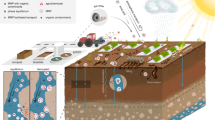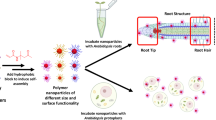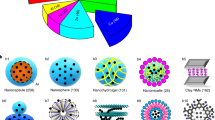Abstract
Large doses of chemical pesticides are required to achieve effective concentrations in the rhizosphere, which results in the accumulation of harmful residues. Precision farming is needed to improve the efficacy of pesticides, but also to avoid environmental pollution, and slow-release formulations based on nanoparticles offer one solution. Here, we tested the mobility of synthetic and virus-based model nanopesticides by combining soil column experiments with computational modelling. We found that the tobacco mild green mosaic virus and cowpea mosaic virus penetrate soil to a depth of at least 30 cm, and could therefore deliver nematicides to the rhizosphere, whereas the Physalis mosaic virus remains in the first 4 cm of soil and would be more useful for the delivery of herbicides. Our experiments confirm that plant viruses are superior to synthetic mesoporous silica nanoparticles and poly(lactic-co-glycolic acid) for the delivery and controlled release of pesticides, and could be developed as the next generation of pesticide delivery systems.
This is a preview of subscription content, access via your institution
Access options
Access Nature and 54 other Nature Portfolio journals
Get Nature+, our best-value online-access subscription
$29.99 / 30 days
cancel any time
Subscribe to this journal
Receive 12 print issues and online access
$259.00 per year
only $21.58 per issue
Buy this article
- Purchase on Springer Link
- Instant access to full article PDF
Prices may be subject to local taxes which are calculated during checkout






Similar content being viewed by others
Data availability
The following raw data can be found in the Supplementary Information: the composition of the soil used to produce all experimental data (Supplementary Tables 2 and 3); the SDS PAGE required to reproduce the data presented in Fig. 3 (Supplementary Fig. 5); the Matlab code required to reproduce the data presented in Figs. 4–6 (Supplementary Code 1).
Code availability
These dimensionless equations were solved using partial differential equation solver function ‘pdepe’ (Matlab). All code was made available in Supplementary Code 1.
References
Aktar, M. W., Sengupta, D. & Chowdhury, A. Impact of pesticides use in agriculture: their benefits and hazards. Interdisc. Toxicol. 2, 1–12 (2009).
Lamberth, C., Jeanmart, S., Luksch, T. & Plant, A. Current challenges and trends in the discovery of agrochemicals. Science 341, 742–746 (2013).
Atwood, D. & Paisley-Jones, C. Pesticide Industry Sales and Usage: 2008–2012 Market Estimates (US Environmental Protection Agency, 2017).
Damalas, C. A. & Eleftherohorinos, I. G. Pesticide exposure, safety issues, and risk assessment indicators. Int. J. Environ. Res. Pub. He. 8, 1402–1419 (2011).
Nuruzzaman, M., Rahman, M. M., Liu, Y. & Naidu, R. Nanoencapsulation, nano-guard for pesticides: a new window for safe application. J. Agr. Food Chem. 64, 1447–1483 (2016).
Vurro, M., Miguel-Rojas, C. & Pérez-de-Luque, A. Safe nanotechnologies for increasing the effectiveness of environmentally friendly natural agrochemicals. Pest. Manag. Sci. https://doi.org/10.1002/ps.5348 (2019).
Kah, M., Kookana, R. S., Gogos, A. & Bucheli, T. D. A critical evaluation of nanopesticides and nanofertilizers against their conventional analogues. Nat. Nanotechnol. 13, 677–684 (2018).
Kookana, R. S. et al. Nanopesticides: guiding principles for regulatory evaluation of environmental risks. J. Agr. Food Chem. 62, 4227–4240 (2014).
Walker, G. W. et al. Ecological risk assessment of nano-enabled pesticides: perspective on problem formulation. J. Agr. Food Chem. 66, 6480–6486 (2018).
Chariou, P. L. & Steinmetz, N. F. Delivery of pesticides to plant parasitic nematodes using tobacco mild green mosaic virus as a nanocarrier. ACS Nano 11, 4719–4730 (2017).
Cao, J. et al. Development of abamectin loaded plant virus nanoparticles for efficacious plant parasitic nematode control. ACS Appl. Mater. Interfaces 7, 9546–9553 (2015).
Guenther, R. H., Lommel, S. A., Opperman, C. H. & Sit, T. L. in Virus-Derived Nanoparticles for Advanced Technologies: Methods and Protocols (eds Wege, C. & Lomonossoff, G. P.) 203–214 (Springer, 2018).
Charudattan, R., Pettersen, M. & Hiebert, E. Use of tobacco mild green mosaic virus (TMGMV) mediated lethal hypersensitive response (HR) as a novel method of weed control. US patent 6689718 (2009).
Charudattan, R. & Hiebert, E. A plant virus as a bioherbicide for tropical soda apple, Solanum viarum. Outlook Pest Manag. 18, 167–171 (2007).
Umekawa, M. & Oshima, N. Sensitivity of tobacco mosaic virus to ultraviolet irradiation. Jpn J. Microbiol. 16, 441–443 (1972).
Rae, C. et al. Chemical addressability of ultraviolet-inactivated viral nanoparticles (VNPs). PLoS ONE 3, e3315 (2008).
Mir, M., Ahmed, N. & ur Rehman, A. Recent applications of PLGA based nanostructures in drug delivery. Colloids Surf. B 159, 217–231 (2017).
Torney, F., Trewyn, B. G., Lin, V. S.-Y. & Wang, K. Mesoporous silica nanoparticles deliver DNA and chemicals into plants. Nat. Nanotechnol. 2, 295–300 (2007).
Hassan, M. E. M., Zawam, H. S., El-Nahas, S. E. M. & Desoukey, A. F. Comparison study between silver nanoparticles and two nematicides against Meloidogyne incognita on tomato seedlings. Plant Pathol. J. 15, 144–151 (2016).
Pestovsky, Y. S. & Martínez-Antonio, A. The use of nanoparticles and nanoformulations in agriculture. J. Nanosci. Nanotechnol. 17, 8699–8730 (2017).
Truong, N. P., Whittaker, M. R., Mak, C. W. & Davis, T. P. The importance of nanoparticle shape in cancer drug delivery. Expert Opin. Drug Deliv. 12, 129–142 (2015).
Barua, S. & Mitragotri, S. Challenges associated with penetration of nanoparticles across cell and tissue barriers: a review of current status and future prospects. Nano Today 9, 223–243 (2014).
Toy, R. The Effect of Particle Size and Shape on the in vivo Journey of Nanoparticles. PhD thesis, Case Western Reserve University (2014).
OECD Guidelines Test for the Testing of Chemicals No. 312: Leaching in Soil Columns (OECD, 2004).
Chen, Z., Li, N., Chen, L., Lee, J. & Gassensmith, J. J. Dual functionalized bacteriophage Qβ as a photocaged drug carrier. Small 12, 4563–4571 (2016).
Quentin, M., Abad, P. & Favery, B. Plant parasitic nematode effectors target host defense and nuclear functions to establish feeding cells. Front. Plant Sci. 4, 53 (2013).
Godfrey, G. H. The depth distribution of the root-knot nematode, Heterodera radicicola, in Florida soils. J. Agri. Res. 24, 93–98 (1924).
Putter, I. et al. Avermectins: novel insecticides, acaricides and nematicides from a soil microorganism. Experientia 37, 963–964 (1981).
Schoenmakers, R. G., van de Wetering, P., Elbert, D. L. & Hubbell, J. A. The effect of the linker on the hydrolysis rate of drug-linked ester bonds. J. Control Release 95, 291–300 (2004).
Steinmetz, N. F. & Manchester, M. Viral Nanoparticles: Tools for Materials Science and Medicine (Pan Stanford, 2015).
Masarapu, H. et al. Physalis mottle virus-like particles as nanocarriers for imaging reagents and drugs. Biomacromolecules 18, 4141–4153 (2017).
Ultman, J. S., Baskaran, H. & Saidel, G. M. Biomedical Mass Transport and Chemical Reaction: Physicochemical Principles and Mathematical Modeling (Wiley, 2016).
Acknowledgements
This work was supported by a grant from the National Science Foundation CAREER DMR 1841848 (to N.F.S.) and NIH EB021911 (to H.B.). We thank H. Hu for providing the PhMV particles used in this study.
Author information
Authors and Affiliations
Contributions
N.F.S. devised the project, the main conceptual ideas and proof outline. P.L.C. developed the technical procedures and performed the experiments, and developed the mathematical model under the supervision of G.M.S. and H.B. A.B.D. and A.G.W. performed the gel electrophoresis technical work under the supervision of P.L.C. The numerical solution of the computational model was executed using Matlab by P.L.C., under the supervision of H.B. P.L.C. and N.F.S. wrote the manuscript; all the authors read or edited the manuscript.
Corresponding author
Ethics declarations
Competing interests
The authors declare no competing interests.
Additional information
Publisher’s note: Springer Nature remains neutral with regard to jurisdictional claims in published maps and institutional affiliations.
Supplementary information
Supplementary information
Supplementary Figs. 1–13, Supplementary Tables 1–5, Matlab codes.
Rights and permissions
About this article
Cite this article
Chariou, P.L., Dogan, A.B., Welsh, A.G. et al. Soil mobility of synthetic and virus-based model nanopesticides. Nat. Nanotechnol. 14, 712–718 (2019). https://doi.org/10.1038/s41565-019-0453-7
Received:
Accepted:
Published:
Issue Date:
DOI: https://doi.org/10.1038/s41565-019-0453-7
This article is cited by
-
Inter-coat protein loading of active ingredients into Tobacco mild green mosaic virus through partial dissociation and reassembly of the virion
Scientific Reports (2024)
-
Conventional agrochemicals towards nano-biopesticides: an overview on recent advances
Chemical and Biological Technologies in Agriculture (2022)
-
Nano-pesticides: the lunch-box principle—deadly goodies (semio-chemical functionalised nanoparticles that deliver pesticide only to target species)
Journal of Nanobiotechnology (2022)
-
Site-selective proteolytic cleavage of plant viruses by photoactive chiral nanoparticles
Nature Catalysis (2022)
-
Development and optimization of a pepino mosaic virus-based vector for rapid expression of heterologous proteins in plants
Applied Microbiology and Biotechnology (2021)



